
Volume 6, Issue 3
December 2002
Holiday Hazards
With the holidays upon us with need to think about our pets and the trouble
they can get into at this time of the year:
- Plants -- Some of the holiday plants can be toxic to our pets. Holly
can cause GI distress and depression, mistletoe can lead to GI problems and various
nervous system signs and poinsettia ingestion can result in increased salivation,
and vomiting.
- Parties -- Holiday parties can cause problems for pets. Pets should
probably not be invited to the parties in your home. Caution guests not to feed
your pets -- holiday foods are often rich and can lead to digestive problems.
Avoid leaving food where animals can get to it. Be especially carefull with
chocolate. Don't allow pets access to alcoholic beverages.
- Ornaments and Decorations -- Dough ornaments are edible but have a high
salt content and ingestion can result in excessive water intake and digestive problems.
Metal ornament hangers can be swallowed as can pins and other fastners. Be
especially careful with the plastic icicles hanging on the tree which can be swallowed
and result in obstructions. The same goes for ribbons and bows.
Have a safe holiday season with your pets.
 Nail Trimming Nail Trimming
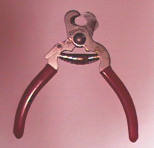
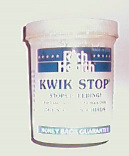
Equipment needed: Nail trimmers and Kwik-Stop®
Dog’s nails or claws are meant to be long. In wild canids they are used as tools for digging,
ripping, gripping and fighting. In the domesticated dog these functions are no
longer useful and long nails lead to problems such as damaging the home environment,
causing injury to people, broken nails resulting in bleeding and trouble walking on hard
surfaces. When a dog’s nails become too long they interfere with the dog’s gait and as the
nails continue to grow, walking will become awkward and painful. In severe cases a
dog’s nails can curl under and grow into the pad of the dog’s paw causing a very serious
and painful infection. These types of ingrown nail problems are most common on the dewclaws.
Nail trimming needs to be done frequently and on a regular basis both to keep the
nails short and to maintain the dog’s training concerning nail trimming. Cutting longer
nails is more uncomfortable to the dog and it is much easier to “quick” a dog or cut into
the tender section of the nail when the nails are long. I recommend trimming the nails
every 2-4 weeks for most dogs. If you let your dog’s nails grow too long then it could take
some time to get them back to a healthy length again. Regularly trimming the tips of your
dog’s nails is the best approach. Some dogs walk and run on rough surfaces and are able
to wear down their nails, but most dogs will need some help. You will get to know how fast
your dog’s nails grow if you routinely inspect your pet’s nails. Even if you don’t actually
trim them each time, regular inspection will help assure that your dog’s feet stay healthy.
So, make nail inspection and trimming an important part of your dog’s routine grooming.
TRAINING SUGGESTIONS
- Dog nail trimming is not painful if you use a sharp nail trimmer and don’t clip the
nails too short. A dull trimmer can put a lot of pressure on your dog's toenail before
it actually cuts through the nail. If this happens your dog may feel an uncomfortable
pinching sensation. This is because the vein in the toenail is being
squeezed. To avoid this always make sure that you're using a sharp pet nail trimmer.
- There is no law requiring all four feet to be trimmed at the same time. If your dog
only tolerates one foot then do one foot. It is better to end the session on a positive
note than to end up with a wrestling match.
- Bring out the clipping tools ahead of time and let your dog become familiar with
them. It is important that you remain calm and confident. If you’re nervous, your
dog will sense it and associate fear or uncertainty with the nail trimming. If your
dog is nervous use gentle reassurance, but don’t “baby” your dog. Let your dog
know that you expect him to behave, but don’t push it too far.
- Many dogs may never like to get their nails trimmed, but if done regularly over
time, dogs can learn to sit through this routine grooming procedure. Other dogs
may never sit still. If you can’t get your dog to sit still you may need to recruit the
help of another person to hold your dog while you trim their nails. While some
dogs can be distracted by dog treats alone, others may also have to be held. You
may want to try clipping your dog’s nails after a full day of exercise when your
dog is looking to take a long nap. Tired dogs tend to be less resistant.
- It is useful with puppies to start handling their feet daily and practice various restraint
techniques. Start nail trimming early and often.
- I use positive reinforcement with food treats during nail trimming. I would use
special treats that are only used for nail trimming and nothing else. Keep plenty
of dog treats on hand to reward good behavior. You can also use dog treats to distract
your pet during dog nail trimming. Treats work great to draw a dog's attention
away from a bleeding nail.
- I like to use Millers Forge® nail trimmers which are shown above. These are side
cutting and very easy to use. They also allow you to see where the cut will be made
better. The blades stay sharper long but cannot be replaced. I have re-sharpened
them. This type of nail trimmer also allows me to make finer cuts with better control
so I don’t have to try to clip the nail perfect with the first cut. I also find the
dogs tolerate this type of trimmer better than the Resco® or guillotine-type nail
trimmer.
- I find if I bend the foot back and cut from behind the dog tolerates the procedure
much better. I also try to keep the leg in a natural position instead of twisting it
sideways or in extreme flexion or extension.
- I always have Kwik-Stop® which is a styptic powder available because you will
“nick” them now and again.
- I often trim the nail tip in a perpendicular direction to blunt the tip of the nail.
- Lastly I try to use a file or coarse sandpaper to file off the sharp edges that remain
from the trimming.
What is the “quick”?
The quick is the living part of a dog’s nail and has blood vessels and nerves running
throughout. Cutting into the quick during dog nail trimming is painful for your dog and
will result in bleeding. If your dog has light colored nails your job will be easier since you
will be able to see the quick which appears as a pink area within the light colored nail. It
will be impossible to see the quick if your dog’s nails are black or dark in color. If your
dog has at least one light colored nail you can usually use that nail as a guide for the others.
If dog nail trimming is completely new to you, ask your veterinarian or groomer to
show you how to trim your dog’s nails or consult a good dog care book. It is also important
to note is that the quick grows with the nail. As a dog’s nails grow longer the quick
will also lengthen. So if your dog’s nails are over grown you will not be able to clip the
nails to the desired length without cutting into the quick. You will need to trim the tips of
your dog’s nails often and over time the quick will recede. To avoid cutting into the quick
you’ll want to start by trimming small pieces of the nail until you get the hang of it.
Trimming your dog’s nails is one of the regular home dog grooming tasks that helps to keep your dog
healthy and active. It also saves wear and tear on the floors and furniture. As with most dog grooming
tasks, rewarding your dog for positive behavior is an important part in your dog’s acceptance of the activity.
It’s worth it to make sure nail trimming is a positive experience for your dog – we never want it to become
a battleground where your dog or you can be injured. Learning to become confident in proper dog
nail trimming, training your dog with positive feedback, and showing patience as well as spending time with
your dog will be a reward in itself.
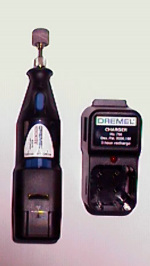
Figure 1.
This figure depicts some of the normal anatomy of the end of the toe. The quick
actually is the dermis or subcutaneous tissue fo the nail - it is also called
the corium. This layer has a rich blood and nerve supply which explains the
bleeding that occurs when this layer is cut with nail trimmers. The epidermis of
the skin has been modified in this area into a hard horny layer which is the wall
of the nail. The sole is a layer of epidermis similar to the wall of the nail
but softer. It is located on the bottom of the nail. The red line shows the proposed
nail trim cut which avoids the quick.
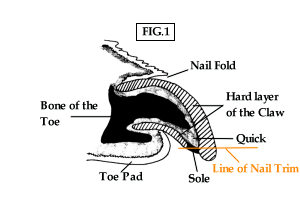
Figure 2.
Here we are looking at the tip of the nail which is fairly easy to do when the foot is flexed back. As you cut the tip of the nail the outside walls of the nail are visible against the softer sole material which it encircles. As you approach the quick a dark center dot much like a bull’s eye begins to show up. This is the tip of the quick and when this is seen it is time to stop the nail trimming procedure. Continuing to cut the nail after reaching this point will result in bleeding.
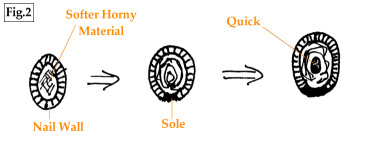
Figure 3.
Fig. 3 is showing the underside of the claw. The hard outer layer of the claw covers the softer horn material and the quick of the corium. By cutting the nail just in front of the softer inner layer the quick can be avoided.
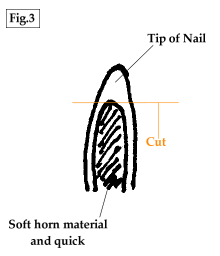
|

